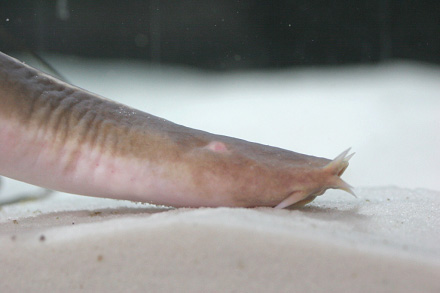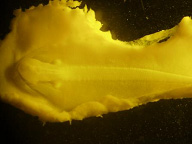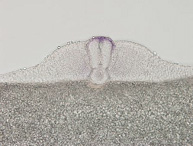| Hagfish first: Elusive organism sheds light on the emergence of the neural crest |
 |
 |

March 19, 2007– The possession of a hinged jaw is a trait shared by many, but not all vertebrates. The cyclostomes, such as lampreys and hagfish, are vertebrate taxa but feed by means of circular mouthparts, which can be used for either predation or scavenging. Even within the Cyclostomata, considerable diversity can be found; indeed the hagfish, in which many primitive traits are preserved, are sometimes considered to be markedly distinct to both the jawed vertebrates (gnathostomes) and the lampreys. It has long been suspected that an analysis of hagfish embryonic development would shed light into the question of its true phylogenetic position, which conceivably is near to the branch point of the vertebrate divergence, but their seafloor habitat is little explored and hagfish eggs have proven extremely difficult to obtain. So difficult, in fact, that the last major research into hagfish development dates back to an 1899 treatise by Bashford Dean.
 |
Hagfish maintained in laboratory aquarium |
A major hurdle on the path to developing a more certain understanding of hagfish ontogeny and phylogeny has now been cleared with a report by Kinya Ota et al. of the Laboratory for Evolutionary Morphology (Shigeru Kuratani; Group Director) of the first significant new study of hagfish development in more than 100 years. The article, published as an Advance Online Publication in Nature, describes the obtainment and analysis of multiple pharyngula-stage embryos of the hagfish, Eptatretus burgeri, yielding new insights into their early development, particularly that of the neural crest.
To collect viable specimens, the group placed eel traps in the waters off the coast of Shimane Prefecture, collecting around 50 live hagfish. “We were lucky to work with some local fisherman who knew the best spots to look for egg-carrying females,” says Ota. “It turns out that it may be easier to catch them in Western Japan, rather than the Pacific Coast, as the costal shelf slopes more gradually there.”
On returning to the CDB, they kept the animals in special aquarium tanks designed to replicate the deep-sea environment of the hagfish as closely as possible, and were rewarded for their efforts with a few dozen eggs, seven of which were fertilized. This in itself was something of an achievement, as hagfish have never successfully been bred in captivity. “We’re not sure what the critical factor in keeping them alive in captivity is,” Ota admits, “but we know that hagfish like cold water and are extremely sensitive to changes in salinity—even a small dilution of salt content can kill them. Their breeding habits are also still a complete mystery.”
 |
 |
EFT: Hagfish pharyngula-stage embryo (anterior to left, gills visible); RIGHT: Sox9 gene expression in embryonic trunk. The stained Sox9-expressing region corresponded to neural crest. |
Histological staining and in situ hybridization of the embryos enabled the Kuratani group to address the question of neural crest development in these phylogenetically important animals. The vertebrate neural crest is a population of delaminated migratory cells, which serves as the source for such a variety of cell types that it is sometimes referred to as the fourth germ layer. Non-vertebrate chordates (such as tunicates and lancelets), however, develop only pockets of relatively immobile epithelial cells. The crucial question for the hagfish was whether this aspect of its development would more closely resemble that of the gnathostomes and lampreys, or that of the non-vertebrates (one previous study had speculated that it would be the latter). Looking at the expression of Sox9 and several other neural crest maker genes, Ota found that the distribution patterns were closely matched to those seen in neural crest development, indicating that the genetic programs at work in the hagfish crest are closely similar to those in other vertebrates.
This new work, made possible by the first-ever artificial breeding of this elusive species, strongly supports the phylogenetic grouping of hagfish with the lampreys other vertebrates. “Although they appear to be quite primitive, the hagfish actually use the same basic developmental program common to the vertebrates, including humans,” notes Kuratani. “This genetic architecture has been preserved over at least 500 million years of evolutionary history, since the time of the divergence of the jawed gnathostomes from the more basal cyclostomes.” The new availability of breeding techniques and viable embryos for this key organism opens up new inroads for molecular embryology toward a better understanding of vertebrate evolution.
|



